Anaxagoras [Clazomenae, 500-428 BC]
Anaxagoras was born in Clazomenae at the coast of Asia Minor around 500
BC. He spent much of his life in Athens, where he was associated with Pericles,
the leading statesman of the age, and with Euripides, the writer of tragedies.
At the time of the two Persian wars (490 BC and 480 BC) the greatness of Athens
was at its peak after the city was victorious two times and gained great prestige
in Greece.
A golden age started; the city became rich and prospered under the wise
leadership of Pericles, who governed, by the free choice of its citizens,
for about thirty years until his fall in 430 BC. "Pericles fell in, it
seems with Anaxagoras, who was a scientific man; and satiating himself with
the theory of things on high, and having attained to a knowledge of the true
nature of intellect and folly, which were just what the discourses of Anaxagoras
were mainly about, he drew from that source whatever was of a nature to further
him in the art of speech." (Plato about Anaxagoras).
With his fall of Pericles' government, Anaxagoras was urged to leave Athens.
He fled to Lampsacus in the Troad where he died, an honoured guest, in 428
BC. Anaxagoras is said to have written only one book. As a follower of the
old Milesian school he tried to revive the thoughts of Anaximenses in the
post-Parmenidean period. Anaxagoras agreed with Empedocles that all coming
into and going out of being is merely the composition and decomposition of
existing substances, but he rejected Empedocles' Love and Strife theory, probably
because there was no scientific reason that spoke for it.
He held that everything is infinitely divisible and that even the smallest
portion of matter contains some of each element. This is in some sense the
antithesis to the later atomistic theory of Leucippus and Democritus. Anaxagoras
held that snow contains the opposites of black and white and is called white
only because white predominates in it. In a sense, then, each part contains
the whole of reality, each thing containing a specific share of all other
things. The differences in form result from different portions of the elements.
The variety of substances and forms we perceive is thus explained by the complexity
of seemingly endless numbers of possible combinations.
Although these thoughts contradicted the dominant Pythagorean and Eleatic schools, they were not entirely new. Yet, Anaxagoras went a step further. The process by which matter is formed, he argued, is separation. The material world, which springs from the all-containing "One" creates itself through continuous dichotomization. It produces forms of multiplicity with increasing complexity. According to Anaxagoras, this process is originated and controlled by "mind" (nous).
Although these thoughts contradicted the dominant Pythagorean and Eleatic schools, they were not entirely new. Yet, Anaxagoras went a step further. The process by which matter is formed, he argued, is separation. The material world, which springs from the all-containing "One" creates itself through continuous dichotomization. It produces forms of multiplicity with increasing complexity. According to Anaxagoras, this process is originated and controlled by "mind" (nous).
The idea of mind as the supreme ordering principle is the most captivating
aspect of his philosophy. Anaxagoras says that "mind is something infinite
and self-controlling, and that is has been mixed with no thing, but is alone
itself by itself." (Simplicius). Unfortunately this is nearly all he
has to say about mind. Neither does he go into detailing the nature of mind,
nor does he present a theory that explains the unfolding of reality on basis
of mind. Anaxagoras' concept of mind stands like an overture without a symphony.
"Together were all things, infinite both in quantity and smallness
- for the small too was infinite. And when all things were together, none
was patent by reason of smallness; for air and ether covered all things, being
both infinite - for in all things these are the greatest both in quantity
and size. [59 B1] For the small there is no smallest, but there is always
a smaller. [B 3] In everything there is a share of everything - except mind
- and in some things mind is present, too. [B 11] Other things possess a share
of everything, but mind is something infinite and self-controlling, and it
has been mixed with no thing. It is the finest of all things and the purest,
and it possesses all knowledge about everything, and it has the greatest strength.
And mind controls all those things, both great and small, which possess soul.
[B 12]" (Simplicius, Commentary on the Physics, 300.27 - 301.10)
Aristotle, who was also a resident of Athens, said a hundred years later
about Anaxagoras: "I once heard someone reading from a book of Anaxagoras
and saying that it is mind which arranges and is responsible for everything.
This explanation delighted me and it seemed to me somehow to be a good thing
that mind was responsible for everything - I thought that in this case mind,
in arranging things, would arrange them all, and place each, in the best way
possible. So if anyone wanted to discover the explanation of anything - why
it comes into being or perishes or exists, he would have to discover how it
is best for it to be or to be acted upon or to act... Now, my friend, this
splendid hope was dashed; for as I continued reading I saw that the man didn't
use his mind at all, he didn't ascribe to it any explanations for the arranging
of things but found explanations in air and ether and water and many other
absurdities."
Aristotle's judgement may sound overly harsh. At any event we can give Anaxagoras
credit for producing an interesting synthesis from the ideas of his influential
predecessors Parmenides who said "All is One", and Empedocles who
held that two opposite forces govern the universe. In the cosmology of Anaxagoras,
these different forces are distinct manifestations of the same "nous".
Although Anaxagoras did not explain it in detail, this idea provided the seed
for later metaphysical speculation.
Anaxagoras was also an astronomer and a man of science. He observed vortexes
and spiral phenomena in nature, which fascinated him. He believed the world
was created through the rotary motion of a spiral, where initially all mass
was united in the center and then, by centrifugal force driven by "mind",
things came into being through the separation of mass into an increasing number
of bodies and substances. It is unlikely that Anaxagoras derived this idea
from the observation of spiral galaxies in space, because their structure
cannot be observed by the naked eye and the Greeks did not have telescopes.
However, it is conceivable that he had concluded this from looking at the
Milky Way, our own galaxy, which appears to us as a band on the firmament.
With some imagination he might have envisioned the band as a disk-shaped spiral
of stars with our own planet being located somewhere along its plane (in fact
our solar system is located in the outer region of one of its arms). Whether
Anaxagoras had a conception of galaxies at all is questionable. There are
no records of such observations and it would take considerable visualization
power to deduce the shape of a spiral galaxy. The successors of Anaxagoras
did not think very highly of his vortex theory, and so the idea was dropped
soon.
Today, we know that if the mass of a galaxy was concentrated at its center,
it would have created a black hole and the gravitation would have been too
strong to allow anything to emerge from it, at least not through rotary motion,
and most likely not through mind. In spite of this, the concept of mind as
the force and the idea that it drives things was highly original and had a
significant impact on later philosophers.
 the uniting force that attracts all things, thereby creating something new,
and Strife (discord) is the dividing force that separates and destroys things.
This notion bears some similarity to the Yin and Yang principles of ancient
China. In the I-Ging, Yin is attributed to the female and Yang is attributed
to the male. Together these two principles govern the totality of existence
while bringing about cyclical changes, depending on whether Yin or Yang assumes
dominance. This is not unlike Empedocles who contends that the history of
the universe is cyclic and eternal and the primary moving factors are Love
and Strife.
the uniting force that attracts all things, thereby creating something new,
and Strife (discord) is the dividing force that separates and destroys things.
This notion bears some similarity to the Yin and Yang principles of ancient
China. In the I-Ging, Yin is attributed to the female and Yang is attributed
to the male. Together these two principles govern the totality of existence
while bringing about cyclical changes, depending on whether Yin or Yang assumes
dominance. This is not unlike Empedocles who contends that the history of
the universe is cyclic and eternal and the primary moving factors are Love
and Strife.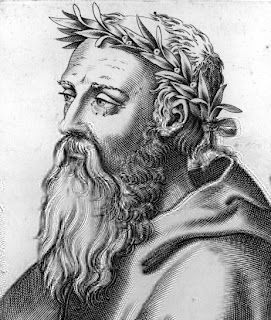



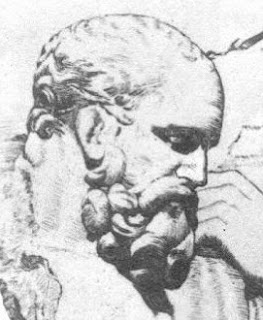
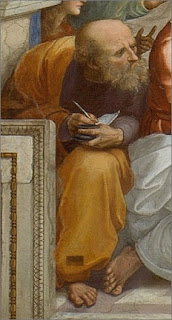

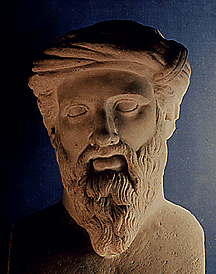
 “The
Egyptians had known that a triangle whose sides are 3, 4, 5 has a right
angle, but apparently the Greeks were the first to observe that
3²+4²=5², and, acting on this suggestion, to discover a proof of the
general proposition. Unfortunately for Pythagoras this theorem led at
once to the discovery of incommensurables, which appeared to disprove
his whole philosophy. In a right-angled isosceles triangle, the square
on the hypotenuse is double of the square on either side.
“The
Egyptians had known that a triangle whose sides are 3, 4, 5 has a right
angle, but apparently the Greeks were the first to observe that
3²+4²=5², and, acting on this suggestion, to discover a proof of the
general proposition. Unfortunately for Pythagoras this theorem led at
once to the discovery of incommensurables, which appeared to disprove
his whole philosophy. In a right-angled isosceles triangle, the square
on the hypotenuse is double of the square on either side. 



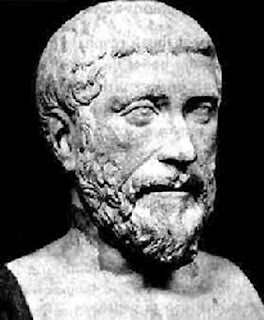
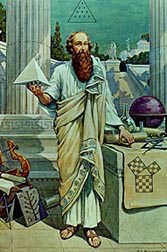

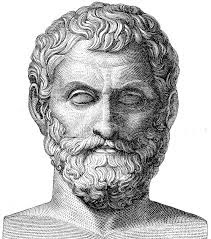
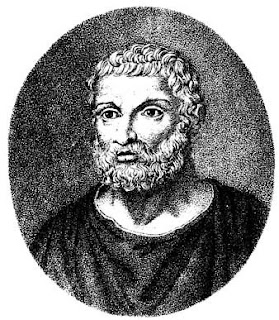
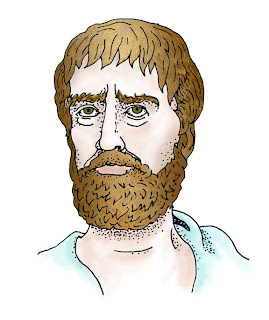
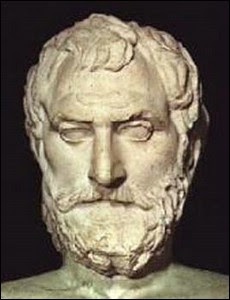

 His
account of meteorology constitutes a most innovative proposition.
Though only partially correct, it is the first recorded attempt of a
scientific explanation of the weather in the history of mankind. But
Anaximander did not stop there. He also founded the sciences of
geography and astronomy. Moreover, he was the first man in Greece who
drew a map of the known world, which was later refined by travellers and
other scholars. This map places Ionia at the centre of the world. To
the East it reaches to the Caspian sea, to the West it ends at the
Pillars of Hercules (the rocks of Gibraltar and Mount Hacho in Morocco).
In the North we see the landmass of Middle Europe and in the South lies
Ethiopia and the lower Nile.
His
account of meteorology constitutes a most innovative proposition.
Though only partially correct, it is the first recorded attempt of a
scientific explanation of the weather in the history of mankind. But
Anaximander did not stop there. He also founded the sciences of
geography and astronomy. Moreover, he was the first man in Greece who
drew a map of the known world, which was later refined by travellers and
other scholars. This map places Ionia at the centre of the world. To
the East it reaches to the Caspian sea, to the West it ends at the
Pillars of Hercules (the rocks of Gibraltar and Mount Hacho in Morocco).
In the North we see the landmass of Middle Europe and in the South lies
Ethiopia and the lower Nile.
 Most people
remember Thales for his famous theorem about right angles that says: A triangle
inscribed in a semicircle has a right angle (see figure on the left). Although
this might seem a simple observation, Thales was the first one who stated
it and thus started what is now generally known as "deductive science",
the process of deriving suppositions and mathematical statements from observation
by means of logic. Circles and angles were not the only objects Thales was
concerned with. Purportedly he also studied magnetism and electrostatic effects,
however, since none of his own works has survived, we don't know what he may
have found out about them.
Most people
remember Thales for his famous theorem about right angles that says: A triangle
inscribed in a semicircle has a right angle (see figure on the left). Although
this might seem a simple observation, Thales was the first one who stated
it and thus started what is now generally known as "deductive science",
the process of deriving suppositions and mathematical statements from observation
by means of logic. Circles and angles were not the only objects Thales was
concerned with. Purportedly he also studied magnetism and electrostatic effects,
however, since none of his own works has survived, we don't know what he may
have found out about them.